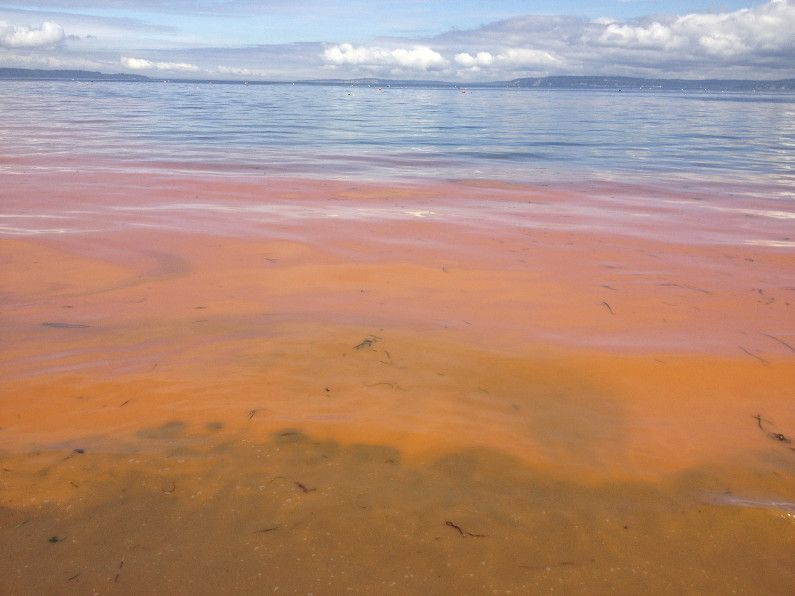Stanford engineers discover how seawater salts affect coastal algae, good and bad
Active chemical agents in saltwater help to break down the byproducts of coastal algae in ways that seem to counteract deadly algal bloom but may have other, less desirable effects.
Scientists have long studied the role that free radicals play in freshwater because of how these charged compounds affect the chemistry of our drinking water. The special nature of these processes in saltwater ecosystems, however, has been poorly understood.
Now civil and environmental engineers at Stanford have discovered how salty free radicals in seawater act as a double-edged sword – sometimes they break down poisonous byproducts of algae but at other times they diminish the supply of beneficial algal byproducts.

Red-orange algal bloom in Puget Sound near Edmonds, Washington, in May 2013. Stanford engineers have discovered the process whereby chemical agents in saltwater help to break down the neurotoxin that is a byproduct of such blooms. (Image credit: Jeri Cusimano / EcologyWA / Creative Commons)
Writing in Proceedings of the National Academy of Sciences, Associate Professor William Mitch and PhD student Kimberly Parker explore the effects of a seawater-specific category of chemical agents known as halogen radicals.
Halogens are the elements such as chlorine and bromine that together with sodium dominate the salt content of seawater. A free radical is a type of oxidant, a compound that is missing an electron. This makes free radicals highly reactive with other chemicals because they steal electrons to make up for their own missing electron.
The free radicals in freshwater are oxygen-based, and are the same types of radicals that cause damage in the human body that you counteract to a degree by consuming and producing antioxidants. In seawater, however, free radicals are halogen-based.
“Most of the research to date has been focused on freshwater because we drink freshwater,” Mitch said. “People have assumed that what goes on in freshwater applies to seawater.”
But when the Stanford duo looked carefully, they saw that the seawater-specific halogen radicals had some special interactions with the algal products found in coastal environments.
Especially along the coast, seawater contains lots of broken down organic matter, including decomposing leaves and plants washed out to the ocean via rivers.
“When you go to the beach and see bubbles when the waves crash, that is due to organic matter soaps left over from fats within algae and other species,” Mitch said.
When molecules of this dissolved organic matter absorb sunlight, the material gets excited enough to become a temporary oxidant. These temporary oxidants steal electrons from the chloride and bromide salts, creating halogen radicals that in turn interact with algal byproducts, notably two compounds, one harmful and the other beneficial.
The harmful algal byproduct is domoic acid, a neurotoxin produced by the Pseudo-nitzschia algae. Last summer and fall, the largest ever recorded algal bloom of Pseudo-nitzschia spread along the Pacific coast from Central California to Alaska, disseminating toxic domoic acid into the seawater.
“One of the major effects it had economically was that it shut down the production of Dungeness crab along the West Coast,” Parker said.
Mitch and Parker found that naturally occurring halogen radicals are capable of breaking down more than half of the domoic acid along the coasts, thereby helping to control the spread of this deadly toxin.
But halogen radicals also degrade about half of the dimethyl sulfide (DMS) produced by algal blooms, which might impact the rate of climate change. DMS ends up in the atmosphere and helps form clouds, which reflect sunlight back into space. The more sunlight reflected back into space, the less heat greenhouse gases can trap in the atmosphere.
Mitch and Parker found that the halogen radicals in seawater are orders of magnitude more effective at degrading domoic acid and DMS than the free radicals in freshwater. The halogen radicals are less reactive than oxygen-based free radicals in freshwater and they specialize in scavenging electrons from easy targets like domoic acid and DMS, two compounds with loosely held electrons.
“Halogen radicals are not wasting time on other compounds,” Mitch said.
Now that Mitch and Parker have discovered the importance of halogen radicals in saltwater, they’re looking at these same free radicals in sea mist. With salt concentrations five to ten times higher in mist than seawater, will the same reactions occur even more intensely?
“People had recognized that salt forms these halogen radicals, but they never said what happens to them – that was the end of the story,” said Mitch.
The Stanford engineers hope this new understanding of halogen radicals will find its way into improving climate models and controlling future coastal algal blooms.
“By understanding the fundamental chemical processes affecting marine algal blooms, we can better understand how blooms like last summer’s, and those in the future, will impact coastal ecosystems,” Parker said.
The paper is titled “Halogen radicals contribute to photo-oxidation in coastal and estuarine waters.” Funding for this research came from the National Science Foundation and the Woods Institute for the Environment at Stanford University. Parker was supported by the Abel Wolman Fellowship from the American Water Works Association (AWWA) and the Gerald Lieberman Fellowship from the Vice Provost for Graduate Education at Stanford University.
